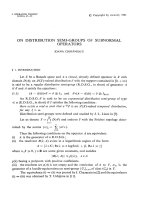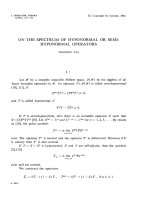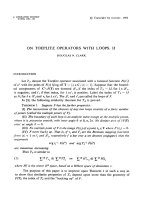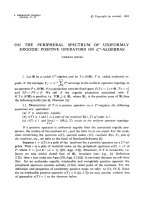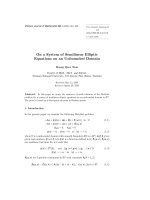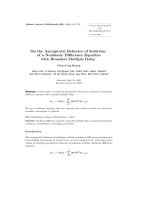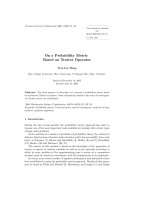Báo cáo toán học: "On a Strange Recursion of Golomb" ppsx
Bạn đang xem bản rút gọn của tài liệu. Xem và tải ngay bản đầy đủ của tài liệu tại đây (282.96 KB, 15 trang )
A SYMMETRIC FUNCTIONS APPROACH
TO STOCKHAUSEN’S PROBLEM
Lily Yen
Department of Combinatorics and Optimization, University
of Waterloo, Waterloo, Ontario, N2L 3G1, Canada
Submitted July 9, 1995. Accepted February 5, 1996.
We consider problems in sequence enumeration suggested by Stockhausen’s prob-
lem, and derive a generating series for the number of sequences of length k on n available
symbols such that adjacent symbols are distinct, the terminal symbol occurs exactly r times,
and all other symbols occur at most r − 1 times. The analysis makes extensive use of tech-
niques from the theory of symmetric functions. Each algebraic step is examined to obtain
information for formulating a direct combinatorial construction for such sequences.
1. Introduction
The score of the piano work nr. 7 Klavierst¨uck XI by Karlheinz Stockhausen (1957) [S]
consists of 19 fragments of music. The performer is instructed to choose at random one
of these fragments, and play it; then to choose another, different, fragment and play that,
and so on. If a fragment is chosen that has already been played twice, the performance
ends. We can state a more general problem as follows: Denote each fragment of music by
asymbol.Thenanr-Stockhausen sequence on n symbolsisasequencesuchthat
(1) adjacent symbols are distinct,
(2) the terminal symbol occurs exactly r times,
(3) no symbol occurs more than r times,
(4) exactly one symbol occurs r times,
(5) the symbol alphabet is N
n
= {1, 2, ,n}.
The original problem posed by Stockhausen is then the case when r = 3 and n = 19. We
shall refer to 3-Stockhausen sequences simply as Stockhausen sequences.Weletc
r
(n, k)
be the number of r-Stockhausen sequences of length k on n symbols, and
s
r
(n):=
(r−1)n+1
k=2r−1
c
r
(n, k),
The research for this paper was supported by the Natural Sciences and Engineering Research Council
of Canada under a postdoctoral fellowship.
Typeset by A
M
S-T
E
X
1
2
for the minimum (resp. maximum) length of an r-Stockhausen sequence is 2r − 1(resp.
(r − 1)n + 1). The expected length of a performance under the assumption that each
fragment is equally likely is given in [RY].
The method of generating series is a major technique in enumeration. In this case, the
determination of the exact number of Stockhausen sequences on n symbols is an enumera-
tive question that can be approached using the theory of symmetric functions for coefficient
extraction in the generating series approach. A generalization of the problem leads to a
combinatorial construction for the Stockhausen sequences. Although only known tech-
niques [G] are used, these are sophisticated, and the problem serves as a useful study of
these techniques, and the algebraic analysis gives partial information about the formulation
of a bijective proof.
The paper is organized as follows. In Section 2, we define a few classical symmetric
functions, and state some properties they satisfy. Section 3 contains the derivation of the
generating series for the number of Stockhausen sequences. In Section 4 we generalize
the method given in Section 3 and give an analogous derivation for the generating series
forthenumberofr-Stockhausen sequences. By examining the generating series for r-
Stockhausen sequences, we give in Section 5 a series of combinatorial constructions that
leads to r-Stockhausen sequences.
2. Symmetric Functions
We review some classical symmetric functions, and recall some properties of the ring of
symmetric functions. The reader is directed to [M] for a fuller account.
Afunctionf(x
1
,x
2
, ) in infinitely many indeterminates is a symmetric function if f
is invariant under any permutation of any finite number of the variables. We shall consider
such symmetric functions over the rationals. The following symmetric functions are used
in the derivation of the generating series for c
r
(n, k).
The complete symmetric function h
n
is defined by
h
n
(x
1
,x
2
, )=
i
1
≤i
2
≤···≤i
n
x
i
1
x
i
2
···x
i
n
.
Moreover, h
0
=1. Ifλ =(λ
1
,λ
2
, ,λ
k
) is a partition, i. e. a non-increasing sequence of
positive integers, we let h
λ
denote h
λ
1
h
λ
2
···h
λ
k
. The weight of λ is |λ| :=
i
λ
i
.
The monomial symmetric function m
λ
is the sum of all distinct monomials of the form
x
λ
1
i
1
···x
λ
k
i
k
,wherei
1
, ,i
k
are distinct.
The power sum symmetric function p
n
is defined by
p
n
(x
1
,x
2
, )=
i
x
n
i
.
Similar to h
λ
, p
λ
is defined to be p
λ
1
p
λ
2
···p
λ
k
.
It is known that [M] each of the sets {h
λ
}, {m
λ
},and{p
λ
},whereλ ranges over all
partitions of n, is a basis of the vector space over of symmetric functions homogeneous
of degree n.
3
Let m
j
(λ) denote the number of j’s in the partition λ. The complete symmetric function
h
n
can be expressed in terms of the power sum symmetric functions as follows:
h
n
=
λn
z
−1
(λ)p
λ
,
where
z(λ)=
j≥1
j
m
j
(λ)
m
j
(λ)!
and λ n indicates that λ is a partition of n. For instance, h
1
= p
1
, h
2
=(p
2
1
+ p
2
)/2, and
h
3
=(p
3
1
+3p
2
p
1
+2p
3
)/6.
There is [M] an inner product ·, · defined on the vector space of symmetric functions
such that m
λ
,h
µ
= δ
λ,µ
,sop
λ
,p
µ
= z(λ)δ
λ,µ
for any two partitions λ and µ,where
δ
λ,µ
is 1 if λ = µ and zero otherwise. It follows that if f and g are symmetric functions,
then p
n
f,g = f,n
∂g
∂p
n
, so the action adjoint to multiplication by p
n
is n
∂
∂p
n
.
For any partition λ,letl(λ) denote the number of parts of λ. Then the number of
monomials on n (≥ l(λ)) symbols of the form x
λ
1
i
1
···x
λ
l(λ)
i
l(λ)
,wherei
1
, ,i
l(λ)
are distinct,
is
(2.1)
n!
(n − l(λ))! m
1
(λ)! m
2
(λ)! ···m
λ
1
(λ)!
= m
λ
(1, ,1
n 1’s
, 0, )=
(n)
l(λ)
m
1
(λ)! m
2
(λ)! ···m
λ
1
(λ)!
,
where (n)
j
= n(n − 1) ···(n − j + 1) denotes the jth falling factorial.
The following proposition is needed and can be regarded as the adjoint form of Taylor’s
Theorem on the ring of symmetric functions.
Proposition 2.1. Let f and g be symmetric functions and u arealnumber,andsuppose
that f = f(p
1
,p
2
, ).Then
f(p
1
,p
2
, ),e
up
j
g = f(p
1
,p
2
, ,p
j−1
,p
j
+ ju,p
j+1
,p
j+2
, ),g.
Proof. We use the adjoint action to multiplication by p
j
,
f(p
1
,p
2
, ),e
up
j
g =
k≥0
u
k
k!
j
k
∂
k
∂p
k
j
f(p
1
,p
2
, ),g
=
k≥0
(uj)
k
k!
∂
k
∂p
k
j
f(p
1
,p
2
, ),g
=
exp
ju
∂
∂p
j
f(p
1
,p
2
, ),g
= f(p
1
,p
2
, ,p
j
+ ju, ),g
using the formal version of Taylor’s Theorem.
4
3. A solution for the original problem
We derive a generating series for the number c
3
(n, k) of Stockhausen sequences on n
symbols of length k. To reach this goal, we begin with the generating series for sequences
satisfying condition (1) for Stockhausen sequences (Lemma 3.1), then we derive the gener-
ating series of sequences satisfying conditions (1) and (2) for r = 3 (Proposition 3.2); and
finally we address the generating series for Stockhausen sequences by imposing appropriate
restrictions in order to satisfy conditions (3) and (4).
Lemma 3.1. The generating series for all strings on n symbols such that adjacent symbols
are different is
D(z,x
1
, ,x
n
)=
1
1 −
n
i=1
zx
i
1+zx
i
,
where z is an ordinary marker for the length of the string and x
i
marks the occurrence of
symbol i.
See [RY,§2] for a proof.
Proposition 3.2. Let D
n
(z, x
1
, ,x
n
) be the generating series of sequences on the sym-
bols {1, 2, ,n} (marked by x
1
, ,x
n
) of length k (marked by z) such that the terminal
symbol occurs exactly three times (non-terminal symbols occur arbitrarily many times) and
adjacent symbols are distinct. Then
D
n
(z,x
1
, ,x
n
)=z
3
n
j=1
x
3
j
n
i=1
i=j
zx
i
1+zx
i
2
1 −
n
i=1
i=j
zx
i
1+zx
i
3
.
Proof. Consider such a sequence which terminates with the symbol j.Thesequencede-
composes into AjBjB
j,whereA, B,andB
are strings on the symbols {1, 2, ,n}\{j}
with distinct adjacent elements, A possibly empty but B and B
non-empty. By Lemma
3.1, the generating series for all such sequences is
z
3
x
3
j
L
w
1
1 − w
n
i=1
i=j
zx
i
1+zx
i
,
where L
w
is the linear transform defined by
L
w
f(w)=
1
2!
∂
2
f
∂w
2
w=1
.
Although we introduce L
w
here to simplify the expression for the generating series, it will
be seen later that it has combinatorial significance. To get the sequences described in the
statement, we take the union over j, and so, summing the above generating series over j
we obtain
D
n
= z
3
n
j=1
x
3
j
L
w
1
1 − w
n
i=1
i=j
zx
i
1+zx
i
.
5
We remark that a very easy direct proof is possible, but L
w
is introduced in order to
illustrate how its counterpart, L
(r)
w
, will be used in Section 4, where for r>3, this linear
transform helps in carrying out the calculations with symmetric functions.
To restrict the frequency of occurrence of symbols, we let P
3
be the set of all partitions
with exactly one 3 as the largest part. For α in P
3
,letx
α
denote x
α
1
1
x
α
2
2
··· and let [x
α
]f
denote the coefficient of x
α
in f;then
[x
α
]D
n
=[x
α
]z
3
p
3
L
w
1
1 − w(zp
1
− z
2
p
2
)
forthepowersumsp
1
,p
2
,p
3
in x
1
,x
2
, ,x
n
.
Let
(3.1) G(z,x
1
, ,x
n
)=z
3
p
3
L
w
1
1 − w(zp
1
− z
2
p
2
)
,
where p
1
, p
2
,andp
3
are power sum symmetric functions in infinitely many indeterminates.
Then
[x
α
]D
n
=[x
α
]G(z,x
1
,x
2
, ,x
n
, 0, 0, ).
Therefore the generating series for the set of all Stockhausen sequences on n symbols is
F
n
(z,x
1
, ,x
n
)=
α∈P
3
β
[x
β
]G(z, x
1
,x
2
, ,x
n
, 0, 0, ),
where the inner sum is over all distinct permutations β of α.
The sequences defined in the statement of Proposition 3.2 satisfy conditions (1) and
(2). Conditions (3) and (4) are imposed by the restriction that all partitions α are in P
3
.
The last condition is imposed by evaluating G with x
n+1
= x
n+2
= ··· = 0 to exclude
n +1,n+2, from the alphabet, and by the sum over β so that each element of the
alphabet N
n
is permitted to occur.
Since G is a symmetric function in the x
i
’s, we may expand it in terms of the monomial
symmetric functions:
G =
θ∈P
3
m
θ
(x
1
,x
2
, )a
θ
z
|θ|
,
where the a
θ
’s are scalars.
Then another way of expressing F
n
is
F
n
=
α∈P
3
m
α
(1, 1, ,1
n
, 0, 0, )[m
α
]G =
α∈P
3
(n)
l(α)
m
1
(α)! m
2
(α)!
a
α
z
|α|
,
because from (2.1) m
α
(1, 1, ,1
n
, 0, 0, ) is the number of terms in the monomial symmet-
ric function m
α
on x
1
,x
2
, ,x
n
, which is equal to the number of sequences over {0, 1, 2, 3}
of length n with n − l(α) occurrences of 0, m
1
(α) occurrences of 1, m
2
(α) occurrences of
2 and one occurrence of 3 (as specified by P
3
).
6
We use the property m
α
,h
θ
= δ
α,θ
of the inner product to extract the coefficient of
m
α
in G.Inordertohavem
1
(α)! and m
2
(α)! in the denominator and one part of size 3
in α, we consider
uh
3
e
u(h
1
+h
2
)
=
α∈P
3
h
α
u
l(α)
m
1
(α)! m
2
(α)!
.
Clearly,
G, uh
3
e
u(h
1
+h
2
)
=
α∈P
3
u
l(α)
m
1
(α)! m
2
(α)!
a
α
z
|α|
.
With the help of the mapping Ξ
n
: u
j
→ (n)
j
,forj =0, 1, 2, , extended linearly to the
power series ring in u, we obtain
F
n
=
k≥0
c
3
(n, k)z
k
=Ξ
n
G, uh
3
e
u(h
1
+h
2
)
.
We are now in a position to work on Φ
3
(z,u):=
n
F
n
(z)u
n
/n!, our goal for this
section.
Lemma 3.3. Let c be independent of u.ThenΞ
n
e
uc
u
k
=(n)
k
(1 + c)
n−k
. If, moreover,
g(u)=1+g
1
u + g
2
u
2
+ ··· is a power series in u,thenΞ
n
e
uc
g(u)=
u
n
n!
e
u(1+c)
g(u).
Proof. The first statement follows from direct computation. Now
Ξ
n
e
uc
g(u)=Ξ
n
k≥0
e
uc
g
k
u
k
=
k≥0
g
k
· (n)
k
(1 + c)
n−k
=
n
k=0
g
k
n!
(n−k)!
(1 + c)
n−k
,
and the second statement follows. Note that (n)
k
=0ifn<k.
It now follows that the generating series for c
3
(n, k)is
Corollary 3.4.
Φ
3
(z,u):=
k,n≥0
c
3
(n, k)z
k
u
n
n!
= e
u
G, uh
3
e
u(h
1
+h
2
)
.
Proof. We know that
k≥0
c
3
(n, k)z
k
= G, Ξ
n
uh
3
e
u(h
1
+h
2
)
= G,
u
n
n!
e
u
uh
3
e
u(h
1
+h
2
)
by Lemma 3.3. Since G is independent of u, the last expression is
u
n
n!
G, e
u
uh
3
e
u(h
1
+h
2
)
=
u
n
n!
e
u
G, uh
3
e
u(h
1
+h
2
)
.
7
It follows that
Φ
3
(z,u)=e
u
G, uh
3
e
u(h
1
+h
2
)
.
To evaluate the inner product, we expand G and uh
3
e
u(h
1
+h
2
)
in terms of the power
sums, and use the property p
λ
,p
µ
= z(λ)δ
λ,µ
of the inner product, the adjoint action to
multiplication by p
j
, and Taylor’s Theorem on the ring of symmetric functions. We know
that upon substitution of G using (3.1)
Φ
3
(z, u)=e
u
L
w
z
3
p
3
1 − w(zp
1
− z
2
p
2
)
,
u
6
(p
3
1
+3p
2
p
1
+2p
3
)e
u(p
1
+(p
2
1
+p
2
)/2)
by linearity of , and ignoring terms in the second argument that are independent of p
3
,
we get
= L
w
e
u
z
3
p
3
1 − w(zp
1
− z
2
p
2
)
,
u
3
p
3
e
u(p
1
+(p
2
1
+p
2
)/2)
by adjoint action of p
3
,wehave
= L
w
e
u
z
3
1 − w(zp
1
− z
2
p
2
)
,ue
u(p
1
+(p
2
1
+p
2
)/2)
using Proposition 2.1 we obtain
= L
w
e
u
z
3
1 − w(z(p
1
+ u) − z
2
(p
2
+ u))
,ue
up
2
1
/2
again by the property of the inner product we ignore terms in the first argument indepen-
dent of p
1
and reach
= L
w
e
u
z
3
1 − wzu + wz
2
u − wzp
1
,ue
up
2
1
/2
.
Since
1
1 − wzu + wz
2
u − wzp
1
=
j≥0
(wzp
1
)
j
(1 − wzu + wz
2
u)
j+1
,
8
we have that
Φ
3
(z,u)=z
3
ue
u
L
w
j≥0
(wz)
j
(1 − wzu + wz
2
u)
j+1
p
j
1
,e
up
2
1
/2
= z
3
ue
u
L
w
j≥0
(wz)
2j
(1 − wzu + wz
2
u)
2j+1
p
2j
1
,e
up
2
1
/2
= z
3
ue
u
L
w
j≥0
(wz)
2j
(1 − wzu + wz
2
u)
2j+1
p
2j
1
,u
j
p
2j
1
2
j
j!
= z
3
ue
u
L
w
j≥0
u
j
(wz)
2j
(1 − wzu + wz
2
u)
2j+1
(2j)!
2
j
j!
.
We summarize the result in the following.
Proposition 3.5. Let L
(r)
w
(f(w)) =
1
r!
∂
r
f
∂w
r
w=1
,then
Φ
3
(z,u)=z
3
ue
u
L
w
j≥0
u
j
(wz)
2j
(1 − wzu + wz
2
u)
2j+1
(2j)!
2
j
j!
.
We remark that the original Stockhausen number s
3
(n)is
u
n
n!
Φ
3
(1,u)=
u
n
n!
1
2
ue
u
j≥0
(2j)(2j − 1)
(2j)!
2
j
j!
u
j
,
so
s
3
(n)=n
n−1
j=0
n − 1
j
2j
2
(2j)!
2
j
.
A direct combinatorial proof of this expression is given in [RY].
4. A generating series for r-Stockhausen sequences
We use the method suggested by the previous section to derive a generating series for
r-Stockhausen sequences.
Theorem 4.1. Let
Φ
r
(z,u):=
n,k≥0
c
r
(n, k)z
k
u
n
n!
be the generating series for the number c
r
(n, k) of sequences of length k on n symbols such
that adjacent symbols are distinct, the terminal symbol occurs exactly r times, and all other
symbols occur at most r − 1 times. Then
Φ
r
(z,u)=uz
r
L
(r−1)
w
Θ
w
exp
u[t
r−1
]
e
wzt/(1+zt)
1 − t
,
9
where z is the ordinary marker for the length of the sequence, u is the exponential marker
for the number of available symbols, L
(r)
w
(f(w)) =
1
r!
∂
r
f
∂w
r
w=1
and Θ
w
is the inverse
Laplace transform Θ
w
: w
j
→ j! w
j
.
We may take advantage of the analysis of the original problem (when r =3).
Proof. Let
F
n,r
:= z
r
p
r
j≥1
(−1)
j−1
z
j
p
j
r−1
1 −
j≥1
(−1)
j−1
z
j
p
j
r
.
Then
c
r
(n, k)=[z
k
]Ξ
n
F
n,r
,uh
r
e
u(h
1
+h
2
+···+h
r−1
)
.
Now
F
n,r
= z
r
L
(r−1)
w
p
r
1 − w
j≥1
(−1)
j−1
z
j
p
j
−1
,
and
k≥0
c
r
(n, k)z
k
=Ξ
n
z
r
L
(r−1)
w
p
r
1 − w
j≥1
(−1)
j−1
z
j
p
j
−1
,uh
r
e
u(h
1
+h
2
+···+h
r−1
)
=
u
n
n!
z
r
L
(r−1)
w
p
r
1 − w
j≥1
(−1)
j−1
z
j
p
j
−1
,uh
r
e
u(1+h
1
+h
2
+···+h
r−1
)
=
u
n
n!
Φ
r
(z, u),
by definition. So
(4.1) Φ
r
(z, u)=uz
r
L
(r−1)
w
p
r
1 − w
j≥1
(−1)
j−1
z
j
p
j
−1
,h
r
e
u(1+h
1
+h
2
+···+h
r−1
)
.
In order to extract the coefficients from (4.1), we perform some technical maneuvers using
the properties of symmetric functions stated in Section 2.
It is convenient for expository purposes to isolate these into a series of steps.
Step 1. Apply the adjoint action to multiplication by p
j
to remove p
j
from the first
argument of the inner product.
Since h
r
=
α∈P
z
−1
(α)p
α
,wherez(α)=1
m
1
(α)
m
1
(α)! 2
m
2
(α)
m
2
(α)! ···, it follows
that
∂h
r
∂p
r
=
1
r
.Also,e
u(1+h
1
+···+h
r−1
)
expanded in terms of the power sums using the
formula above is independent of p
r
,so
Φ
r
= uz
r
L
(r−1)
w
1 − w
j≥1
(−1)
j−1
z
j
p
j
−1
,e
u(1+h
1
+···+h
r−1
)
= uz
r
L
(r−1)
w
1,
1 − w
j≥1
(−1)
j−1
z
j
j
∂
∂p
j
−1
e
u(1+h
1
+···+h
r−1
)
.
10
Step 2. Introduce the mapping Θ
w
: w
j
→ j! w
j
to express
1 − w
j≥1
(−1)
j−1
z
j
j
∂
∂p
j
−1
as an exponential function, and h
j
’s in terms of the power sums so that the ring theoretic
Taylor’s Theorem can be used.
Since
1 − w
j≥1
(−1)
j−1
z
j
p
j
−1
=Θ
w
e
w
j≥1
(−1)
j−1
z
j
p
j
,
Φ
r
= uz
r
L
(r−1)
w
Θ
w
1,e
w
j≥1
(−1)
j−1
z
j
j
∂
∂p
j
e
u(1+h
1
+···+h
r−1
)
The generating series for the complete symmetric functions is
k≥0
h
k
t
k
=
∞
i=1
(1 −
tx
i
)
−1
,so
1+h
1
+ ···+ h
r−1
=[t
r−1
]
1
1 − t
∞
i=0
(1 − tx
i
)
−1
=[t
r−1
]
1
1 − t
exp
i≥1
ln(1 − tx
i
)
−1
=[t
r−1
]
1
1 − t
e
p
1
t+p
2
t
2
+···
.
Thus e
u(1+h
1
+···+h
r−1
)
=exp
u[t
r−1
]
e
p
1
t+p
2
t
2
2
+···
1−t
.
Step 3. Apply Taylor’s Theorem to get
Φ
r
= uz
r
L
(r−1)
w
Θ
w
1,e
w
j≥1
(−1)
j−1
z
j
j
∂
∂p
j
exp
u[t
r−1
]
e
p
1
t+p
2
t
2
2
+···
1 − t
= uz
r
L
(r−1)
w
Θ
w
1, exp
u[t
r−1
]
e
(wt+p
1
)+(−2wz
2
+p
2
)
t
2
2
+···
1 − t
= uz
r
L
(r−1)
w
Θ
w
1, exp
u[t
r−1
]
e
wzt−wz
2
t
2
+···
1 − t
since the inner product is with 1, all p
i
, i ≥ 1, are set to 0 in the second argument of the
inner product.
We conclude that Φ
r
= uz
r
L
(r−1)
w
Θ
w
exp
u[t
r−1
]
e
wzt/(1+zt)
1−t
.
We remark that the exponential e
wzt/(1+zt)
is the generating function for Laguerre
polynomials. A short proof of the r-Stockhausen problem that is inspired by this analysis
isgivenin[RY,§5]. An explicit formula derived from this expression for the number of
r-Stockhausen sequences and a direct combinatorial proof are given in [Y].
11
5. Combinatorial constructions
We have shown that the generating series for generalized Stockhausen sequences is
Φ
r+1
(z, u):=
n,k≥0
c
r+1
(n, k)z
k
u
n
n!
= uz
r+1
L
(r)
w
Θ
w
exp
u[t
r
]
1
1 − t
exp
wzt
1+zt
,
where
L
(r)
w
(f)=
1
r!
w
r
∂
r
f
∂w
r
w=1
and Θ
w
: w
k
→ k!w
k
.
The combinatorial nature of the transformations leads one to ask whether combinatorial
objects and constructions exist for each expression so that one can obtain generalized
Stockhausen sequences directly. In this section, we present a series of constructions that
has generalized Stockhausen sequences as the final consequence. The set-wise actions
of the constructions are suggested by the algebraic analysis, although the element-wise
actions (the combinatorial content) have to be supplied. Therefore we define first the set
A generated by
A =
1
1 − w(
n
i=1
zt
i
1+zt
i
)
,
which is a fundamental structure in the series of constructions. Next, we convert the
univariate series in t intoamultivariateseriesint
1
, t
2
, , t
n
to obtain n non-terminal
symbols in the Stockhausen sequences. To this end, we exhibit a bijection between sets
which are enumerated by
u
n
n!
Θ
w
exp
u[t
r
]
1
1 − t
exp
wzt
1+zt
and
[t
r
1
t
r
2
t
r
n
]
1
1 − w(
n
i=1
zt
i
1+zt
i
)
n
i=1
1
1 − t
i
.
Once we have all n non-terminal symbols, we give a combinatorial interpretation for the
transformation L
(r)
w
. After the application of L
(r)
w
to A, the last step is the placement of
r + 1 copies of the terminal symbol to make (r + 1)-Stockhausen sequences.
Step 1. Signed Divided Strings. To construct strings with distinct adjacent elements,
an argument involving the principle of inclusion–exclusion can be applied. However, one
can also consider signed sets asdescribedin[SW].Thesetofsigned divided strings is a
signed set of strings with dividers such that
(1) different symbols are separated by dividers,
(2) the same symbol appearing in a block may be separated by dividers,
12
(3) no dividers are adjacent, and no string ends with a divider,
(4) the sign of the string is
(−1)
# (undivided even sub-strings)
.
An example of a typical signed divided string is +t
1
t
1
wt
1
wt
2
t
2
wt
3
wt
1
,wherew marks the
divider and t
1
, t
2
and t
3
are symbols.
Let A be the set of strings on n symbols such that a non-empty string begins with a
divider. Let the symbols be zt
1
,zt
2
, ,zt
n
,andletw be an ordinary marker for dividers.
Then the ordinary generating series for A is
A(w, z, t
1
, ,t
n
)=
1
1 − w(
n
i=1
zt
i
1+zt
i
)
.
Step 2. A Bijection. We define sets generated by
[t
r
1
t
r
2
t
r
n
]
1
1 − w(
n
i=1
zt
i
1+zt
i
)
n
i=1
1
1 − t
i
,
and
u
n
n!
Θ
w
exp
u[t
r
]
1
1 − t
exp
wzt
1+zt
,
and show a bijection between the sets. From the previous section, the series
A(w, z, t
1
, ,t
n
)=
1
1 − w(
n
i=1
zt
i
1+zt
i
)
generates all, possibly empty, signed divided strings where a non-empty string begins
with a divider marked by w. The multiplication of A by
n
i=1
1
1−t
i
and the extraction
of the coefficient of t
r
1
t
r
2
···t
r
n
in the result corresponds at the set theoretic level to the
concatenation of the signed divided strings in A with t
i
1
1
t
i
2
2
···t
i
n
n
for 0 ≤ i
1
,i
2
, ,i
n
and
the restriction to only those concatenated strings with exactly rt
i
’s, i =1, 2, ,n.But
this is equivalent to considering the strings in A with no more than rt
i
’s for i =1,2, ,n.
Thus we conclude that
[t
r
1
t
r
2
t
r
n
]
1
1 − w(
n
i=1
zt
i
1+zt
i
)
n
i=1
1
1 − t
i
generates all signed divided strings (⊂A) with no more than rt
i
’s (i =1, ,n) in each
string.
For
u
n
n!
Θ
w
exp
u[t
r
]
1
1 − t
exp
wzt
1+zt
,
13
or equivalently,
Θ
w
[t
r
]
1
1 − t
exp
wzt
1+zt
n
,
where Θ
w
is an inverse Laplace transform on w,i.e.Θ
w
: w
k
→ k! w
k
, we describe a set
generated by the inner expression
[t
r
]
1
1 − t
exp
wzt
1+zt
n
first, and then apply Θ
w
combinatorially to the set.
Consider a labelled ordered n-tuple (S
1
,S
2
, ,S
n
) of possibly empty, ordered sets of
all possible sizes. That is, given a label set (⊂N := {1, 2, })ofsizen,labelS
1
with the
smallest label, S
2
with the next label, etc, and S
n
with the largest one. Every coordinate
in S
i
, i ∈N
n
, is also labelled from a label set ⊂N in the same way. A typical entry of S
i
has the form (−1)
k+1
w
x
(zt)
k
(k ≥ 1), where x is the label associated with that entry of
S
i
.Letw be an exponential marker for the labels w
x
’s. When we restrict the number of
t’s in each S
i
to no more than r, then the generating series for S
i
is
[t
r
]
1
1 − t
w
|S
i
|
|S
i
|!
zt
1+zt
|S
i
|
.
Summing over all |S
i
| from 0 to ∞,weget
[t
r
]
1
1 − t
exp
wzt
1+zt
n
as the generating series for the n tuple of tuples. To apply Θ
w
, or inverse Laplace transform,
i. e. removal of labels marked by w, we form signed divided strings in the following way.
Take the entry in some S
x
that has the label w
1
, and put down the entire entry including
its sign as the first segment, w
1
zt
i
zt
i
···zt
i
writing t
i
instead of t if the set S
x
has the
symbol i assigned to it. In the second segment, find some set S
y
that contains w
2
,and
write w
2
zt
j
zt
j
if S
y
has symbol j assigned to it. Continue in a similar manner until
the w’s are exhausted. Now combine the signs multiplicatively and erase the subscripts on
w to get a signed divided string on n available symbols because there are nS
x
’s, such that
every t
i
appears no more than r times (since we start out with r or fewer t’s in each S
x
).
Step 3. Application of L
(r)
w
. Let B be the set of non-empty strings on n symbols such
that a non-empty string begins without a divider. Let the symbols be zx
1
,zx
2
, ,zx
n
,
and let w be an ordinary marker for dividers. Then the ordinary generating series for B is
B(w, z, x
1
, ,x
n
)=
n
i=1
zx
i
1+zx
i
1 − w(
n
i=1
zx
i
1+zx
i
)
.
Let ω be a divider. Define ω
r
× (
∂
∂ω
)
r
/Σ
r
(see [GJ, p.36]) to be an operation on the
elements of the sets A (as defined in Step 1) and B that marks r distinct dividers in all
14
possible ways regardless of the order in which dividers are marked. (Here Σ
r
denotes the
symmetric group on r elements.) Then
(ω
r
× (
∂
∂ω
)
r
/Σ
r
)A
∼
−→Aˆω BˆωBˆω ··· ˆwB
r B’s
by induction on r,since
ω∂
∂ω
A
∼
−→AˆωB and
ω∂
∂ω
B
∼
−→BˆωB.
Notice that A(1,zx
1
, ,zx
n
) (respectively B(1,zx
1
, ,zx
n
)) is the ordinary generating
series for possibly empty (respectively non-empty) strings on n symbols zx
1
, ,zx
n
such
that adjacent symbols are distinct. Therefore, the operator L
(r)
w
applied to A gives the
generating series for (
˜
A,
˜
B, ,
˜
B)withr
˜
B’s, where
˜
A (respectively
˜
B)istheresultof
ignoring dividers in the set A (respectively B). This is an (r + 1)-tuple of strings such that
adjacent symbols are distinct, and the first string (but no others) may be empty.
In short, the purpose of L
(r)
w
is first to mark ω’s and secondly get rid of strings that have
at least one undivided sub-string of length greater than or equal to 2 (by setting w =1
algebraically or ignoring dividers, ω’s, set theoretically).
Step 4. Placement of the terminal symbol. Given n + 1 symbols such that the
terminal symbol occurs r +1 times, let u be an exponential marker for the available
symbols, z be an ordinary marker for the length of the string, and t
1
, ,t
n
be ordinary
markers for the occurrence of the non-terminal symbols, then
uz
r+1
L
(r)
w
Θ
w
exp
u[t
r
]
1
1 − t
exp
wzt
1+zt
is the generating series for T∗S(see [GJ, p. 163] for the definition of ∗), where T is the
set containing r + 1 copies of the terminal symbol t,andS is (A|
w=1
, B|
w=1
, ,B|
w=1
)
with r B’s. The ∗ product is used because the symbols t, t
1
, ,t
n
form the label set
{1, 2, ,n,n+1}. To obtain Stockhausen sequences from T∗S,placezt in front of each
B, and at the final position, then remove all commas, and let z commute with the t’s.
Therefore, z marks the length of the string, and the string is faithfully represented by the
t’s.
Acknowledgements
The author would like to thank L. Butler and D. M. Jackson for teaching her the theory
of symmetric functions and D. M. Jackson for guiding her through the symmetric maze,
and comments that have improved the presentation of the paper. The author would also
like to thank the reviewer for many helpful suggestions.
15
References
[G] I. Gessel, Symmetric functions and P-recursiveness,J.CombinatorialTheory53 (1990), 257–285.
[GJ] I. P. Goulden & D. M. Jackson, Combinatorial Enumeration, Wiley Interscience, New York, 1983.
[M] I.G.Macdonald,Symmetric Functions and Hall Polynomials, Edition 1, Clarendon Press, Oxford,
1979.
[RY] R. C. Read & L. Yen, A Note on The Stockhausen Problem, J. Combin. Theory Ser. A (to appear).
[SW] D. Stanton & D. White, Constructive Combinatorics, Undergraduate Texts in Mathematics, Sprin-
ger-Verlag, New York, 1986.
[S] K. Stockhausen, nr. 7 Klavierst¨uck XI, 12654 LW, Universal Edition, London, 1979.
[Y] L. Yen, A direct combinatorial proof for Stockhausen’s problem, Research Report, University of
Waterloo, Dept. of Combinatorics & Optimization (1995), pp. 7.

